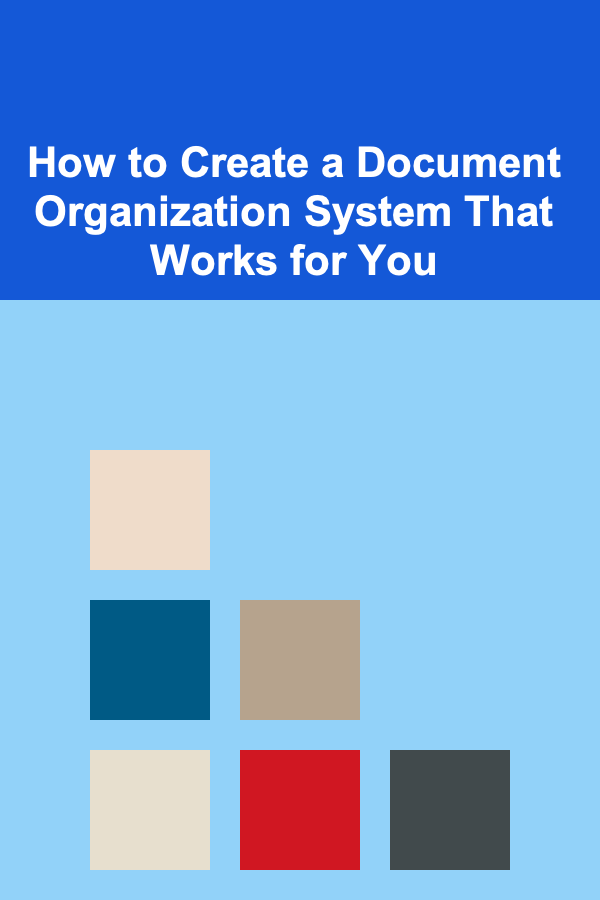
How to Create a Document Organization System That Works for You
ebook include PDF & Audio bundle (Micro Guide)
$12.99$8.99
Limited Time Offer! Order within the next:

In today's fast-paced world, managing documents efficiently has become more crucial than ever. Whether you are a student juggling assignments, a professional handling work-related documents, or simply someone looking to keep personal files organized, having a robust document organization system is essential. A well-structured system can save you time, reduce stress, and enhance productivity. This article will guide you through creating a document organization system tailored to your needs.
Understanding the Importance of Document Organization
Before diving into the specifics of creating an organization system, it's essential to understand why document organization is vital.
Benefits of Document Organization
- Increased Efficiency: An organized system allows for quicker retrieval of information, saving valuable time.
- Reduced Stress: Clutter can contribute to anxiety. Knowing where your documents are can provide peace of mind.
- Improved Collaboration: If you work in teams, a shared organization system fosters better communication and collaboration.
- Enhanced Productivity: By minimizing distractions, you can focus on more critical tasks, ultimately boosting productivity.
- Better Compliance: For businesses, an organized document system ensures compliance with legal and regulatory requirements.
Assessing Your Current Document Management Practices
Before creating a new system, evaluate how you currently manage documents.
Identify Pain Points
Consider the challenges you face:
- Are you often unable to find important documents?
- Do you have multiple versions of the same file?
- Is your workspace cluttered with paper?
Document Inventory
Conduct an inventory of all your documents, both physical and digital. Categorize them by type (e.g., personal, educational, work-related) and assess their current state.
Analyze Usage Patterns
How frequently do you access various documents? Identifying high-use files can help prioritize how you organize them.
Defining Your Goals for Organization
Once you've assessed your current practices, define clear goals for your organization system.
Specific Goals
- Efficiency: Aim to reduce the time spent searching for documents by at least 50%.
- Clarity: Ensure that anyone accessing your documents can easily understand your organization system.
- Accessibility: Make sure important documents are accessible from anywhere, especially if you work remotely.
- Sustainability: Design a system that is easy to maintain long-term.
Choosing the Right Tools
Selecting the right tools can significantly impact the effectiveness of your document organization system.
Digital Tools
-
File Storage Solutions
- Cloud Services: Google Drive, Dropbox, OneDrive
- Document Management Systems: M-Files, DocuWare
-
Note-taking Apps
- Evernote: Great for organizing notes and related documents.
- Notion: Highly customizable for project management and documentation.
-
Task Management Tools
- Trello: Use boards and cards to organize documents related to projects.
- Asana: Track progress on document-related tasks.
Physical Tools
- File Cabinets: For physical document storage, opt for labeled file cabinets or boxes.
- Binders: Use binders for organizing paperwork related to specific topics or projects.
- Labels: Invest in a label maker for clear and consistent labeling of folders and documents.
Creating a Logical Folder Structure
A logical folder structure forms the backbone of your document organization system.
Top-Level Folders
-
Personal
- Subfolders: Finance, Health, Travel, etc.
-
Educational
- Subfolders: Course Materials, Assignments, Research, etc.
-
Professional
- Subfolders: Projects, Reports, Meetings, etc.
Hierarchical Structure
Use a hierarchical structure that makes sense. For example:
- Main Folder: Educational
- Subfolder: University
- Subfolder: Courses
- Subfolder: [Course Name]
- Subfolder: Courses
- Subfolder: University
Shortcuts and Favorites
For frequently accessed folders, use shortcuts or favorites in your file explorer to enhance accessibility.
Implementing Consistent Naming Conventions
Having a consistent naming convention helps identify documents quickly.
Standardizing Names
-
Include Key Information: Date, type, and subject can be included in the file name.
- Example:
2023-09-30_Project_Report_Version1.docx
- Example:
-
Avoid Special Characters: Stick to letters and numbers to avoid issues with file systems.
-
Be Descriptive but Concise: Aim for clarity without excessive length.
Version Control
If you regularly update documents, ensure you have a version control system in place.
- Use dates or version numbers in file names to differentiate between edits.
Utilizing Tags and Metadata
Tags and metadata can add another layer of organization, making it easier to search for and categorize documents.
Implementing Tags
- Tag Types: Consider using tags for document status (e.g., Draft, Finalized), priority (High, Medium, Low), or project names.
- Searchable: Many modern document management systems allow tagging, enhancing searchability.
Metadata
For advanced users, consider embedding metadata directly into documents. This includes details like the author, creation date, and keywords.
Establishing a Regular Maintenance Routine
An organization system requires upkeep to remain effective.
Scheduled Reviews
Set aside time---monthly or quarterly---to review your documents. During this review:
- Delete unnecessary files.
- Archive old documents that are no longer actively needed.
- Update any outdated information.
Consistency is Key
Make organization a habit. Every time you create or receive a document, immediately file it in the appropriate location.
Backup and Security Considerations
Protecting your documents should be a priority in your organization system.
Backup Solutions
- Cloud Backups: Utilize services like Google Drive and Dropbox for automatic backups.
- External Drives: Maintain a physical backup on an external hard drive.
Security Measures
- Password Protection: Secure sensitive documents with passwords.
- User Permissions: For shared folders, establish user permissions to control who can view or edit documents.
- Encryption: Use encryption for highly confidential documents, ensuring unauthorized users cannot access them.
Evaluating and Adjusting Your System
No organization system is perfect; regular evaluation is necessary to improve efficiency.
Gather Feedback
If your system is used by others, seek feedback on what works and what doesn't. Pay attention to common pain points.
Metrics for Success
Track metrics such as time spent locating documents before and after implementing your system. Use these insights to make data-driven adjustments.
Adaptation
As your needs evolve, be willing to adapt your organization system. New tools, workflows, or categorization methods may become necessary over time.
Conclusion
Creating a document organization system that works for you involves careful planning, implementation, and ongoing management. By understanding your specific needs, defining clear goals, choosing the right tools, and establishing a logical structure, you can develop a system that enhances your productivity and reduces stress.
Regular maintenance and adaptation ensure that your system remains effective in a constantly changing environment. Ultimately, an efficient document organization system enables you to spend less time searching for files and more time focusing on what truly matters.
With the strategies outlined in this article, you are now equipped to create a document organization system tailored to your unique needs, leading to a more organized and productive life. Happy organizing!
Reading More From Our Other Websites
- [Home Party Planning 101] How to Organize a Fun and Relaxed Brunch Party at Home
- [Personal Investment 101] Turning Deep Learning into Passive Income: Ideas and Strategies
- [Personal Care Tips 101] How to Use Concealer to Cover Acne Scars
- [Home Storage Solution 101] How to Optimize Bedroom Storage for Minimalist Living
- [Home Cleaning 101] How to Naturally Clean Your House: Safe and Effective Alternatives
- [Personal Financial Planning 101] How to Create a Financial Plan for Your Family's Future
- [Scrapbooking Tip 101] DIY Scrapbooking Adhesive Hacks: Homemade Options That Work Wonders
- [Personal Investment 101] How to Leverage a 529 Plan for College Savings Without Over-Contributing
- [Screen Printing Tip 101] Step-by-Step Tutorial: Applying and Curing Screen Printing Emulsion Like a Pro
- [Simple Life Tip 101] Best Evening Wind‑Down Practices to Unplug and Embrace Simplicity

How to Keep Your Holiday Decorating Minimalist
Read More
How to Optimize Your Website's Content for Search Engines
Read More
How to Navigate Online Dating Messaging
Read More
How To Deal with Car Sickness in Dogs
Read More
How to Create Interactive Greeting Cards
Read MoreHow to Automate Your Retirement Savings Contributions Tracking
Read MoreOther Products

How to Keep Your Holiday Decorating Minimalist
Read More
How to Optimize Your Website's Content for Search Engines
Read More
How to Navigate Online Dating Messaging
Read More
How To Deal with Car Sickness in Dogs
Read More